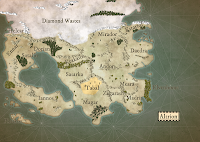 |
| Battlesystem V1 stat block |
"Particularly welcome is the reduction of relevant statistics from a dozen-plus to a mere five."Now he has a point (but as I've commented before, this comes at the price of an over-simplified buckets-of-odd-sided-dice system - in case you haven't got the message yet, I was really disappointed in BattleSystem V2). But if you look at the stat block for a BattleSystem V1 unit, and compare it to a 5E monster stat block, they actually look pretty similar barring still needing to calculate morale/discipline levels (which you still do in V2!) and figure ratio. Which kind of blows that criticism out of the water: after all, if you don't have to draw the stat blocks up because they're already there...
 |
| 5E stat block |
And then I looked a little closer, and realised the thing 5E stat blocks have that means you can probably get rid of the BattleSystem V1 Combat Results Table - static hits and damage.
Let's look at the old CRT. A THAC0 unit with d8 weapons is going to do between 3 and 8 HD of damage (most likely 2d6 roll is a 7, which gets us 5 HD) to its AC10 target. If that's a 1HD, 10:1 unit, that's between .3 and .8 of a figure with an expected value of .5, i.e. one hit in two from the figures in the unit.
In 5E terms each figure unit is going to have static damage of 5 and its target is going to have 5HP, or 50HP per 10:1 figure. If we rolled this up as a series of 5E combats, we'd expect 50% of them to result in a hit, which would mean we'd do 25 HP total, i.e. an expected value of .5 of a figure. That's interesting, and almost certainly not a coincidence.
Hmm. We can do something with this, surely?
 |
| Straight line is the odds on rolling a given number on 1d20, curved on 3d6. |
We could just roll for a hit, and multiply it out adjusting for how much you hit or miss by. However, that is going to produce a lot more extreme results for (say) a unit of 10 10:1 figures than 100 individual rolls. There's an easy fix for that, though: if we swap our d20 for 3d6, it has almost the same range (3-18) and close enough to the same average (10.5) not to matter, and much fewer extreme results - see the graph.
Let's do that, then, and say that for an exact success, we hit 50% of the time, and adjust that figure by 10% for each number we hit/miss by (up to a max of 100% and a minimum of 0%). This does make it harder to hit if your target roll is well above 10 (i.e. your target has relatively high AC compared to your attack bonus) but I'm not actually sure that's an issue: you'll still do some damage.
Right: time to try a couple of examples in the good old spreadsheet.
 |
| Red-shaded cells truncate to 0. Purple column is the most likely outcome, and the green cell is the actual target number. Click for a better view. |
Thoughts?
(Oh, next up: command and control and unit activation. Trust me, it'll be worth it.)
(Oh, next up: command and control and unit activation. Trust me, it'll be worth it.)
















